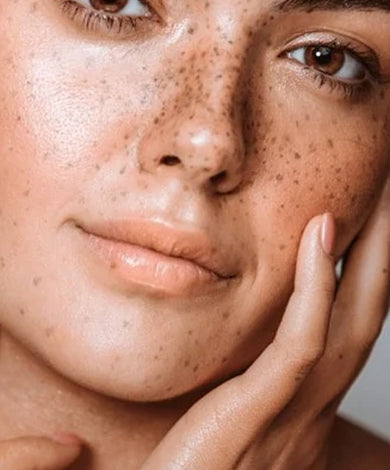Why do I have dark spots on my skin?


UNDERSTAND MY SKIN
Why do I have dark spots on my skin?
The colour of a person’s skin is usually determined by their phototype and how much sun exposure they get; areas frequently exposed to the sun are darker than those that are covered. Melanin is the natural pigment that controls skin colour, which the body secretes to protect skin from UV rays, leading to tanning.
Pigmentation problems are linked to poor melanin functioning, which causes either hyperpigmentation (dark spots) or depigmentation (lighter spots) on the skin. The latter is usually related to a condition such as vitiligo or albinism, which requires medical care.

The skin has a natural colour independently of sun exposure: this is its pigmentation.
This colour depends on skin cells called melanocytes, which are unique in that they produce pigments known as melanin. This melanin found in the skin offers natural protection against the ultraviolet (UV) rays emitted by the sun.
What is pigmentation?

There are two types of melanin:
-
1/ Eumelanin
Better known as real melanin, it is black or dark brown and found in people with matte skin (it protects from UV rays). -
2/ Phaeomelanin
This is also known as red or redhead melanin. It is present in people with fair skin or red hair. It doesn’t protect against UV rays; on the contrary, its synthesis generates free radicals that attack the skin
These two types of melanin are present in each individual in varying proportions. The amount is what determines a person’s natural skin colour and how well they tan when exposed to the sun.
How does pigmentation work?
Pigmentation is the result of a complex 4-stage process:

1/ Ultraviolet rays and “biological mediators” (substances found in the skin’s cells) stimulate the pigmentation process and therefore the melanin-producing function of cells called melanocytes.

2/ Melanin is produced by melanocytes.

3/ The melanin thus produced is distributed through the two layers of the epidermis.

4/ It then migrates to the skin’s surface through the ongoing renewal of cells in the epidermis.
Spots linked to sun exposure and age
UV rays cross through the epidermis and stimulate the skin’s pigmentation cells (melanocytes). Some melanocytes are continuously disrupted and start to secrete large amounts of melanin all the time. Spots appear when melanin production increases in an abnormal manner and when over-produced melanin isn’t uniformly distributed over the skin’s surface. This causes it to accumulate in certain spots and form unsightly marks.

Excessive sun exposure (too intense or too long) over time results in the over-production of melanin, leading to pigment spots or lentigos (small, round and flat spots that vary in size).
That is why people who work outdoors (people in the marine industry, construction workers, etc.) tend to develop these spots earlier than other people.

Moreover, the risk of hyperpigmentation increases with cell ageing and generally affects the areas that are most exposed to the sun over time (face, neck, hands, etc.). The sun and age are the main causes of pigment spots. This is called either solar lentigo or senile lentigo. Lentigo affects 90% of white people over the age of 50 years. All skin types are affected.
Spots linked to hormonal changes and oral contraceptives
Hormonal changes during pregnancy or when taking oral contraceptives can also cause hyperpigmentation.
In brown-haired women (with matte skin), hormonal changes may lead to the appearance of a brown mask on the face called "melasma" or a "pregnancy mask". This refers to spots located on the upper face, sparing the edge of the scalp. They become more pronounced in the summer. Their colour varies and darkens under the action of ultraviolet radiation.
This common pigmentation appears suddenly but decreases or completely disappears after hormones have returned to normal (after the birth of a child for example). Residual pigmentation may however persist for another few months or another few years.
In certain cases, a “pregnancy mask” sometimes appears even when a person isn’t pregnant or taking oral contraception.

Spots linked to phototoxic substances and skin lesions
When exposed to the sun, certain plant species (plant essences), fragrances and medicines can cause brown spots to appear after a photosensitisation (phototoxicity) reaction.
Furthermore, damaged or scarred skin (after-effects of burns, sunburns, healing of inflammatory lesions, particularly acne lesions) develops pigmentation marks more easily if exposed to UV rays.
What should I do?
The best approach is systematically applying photoprotection in the sunniest months together with behaving responsibly in relation to the sun.
- Protect yourself from the sun to prevent pigmentation marks from appearing or getting worse. Avoid the sun when its rays are the most dangerous, that is, between 10 am and 3 pm.
- Choose your photoprotection carefully. Its sun protection factor (SPF) should be at least 20 (or 30 if you have fair skin).
- Take oral dietary supplements (capsules or tablets) before and during exposure to better prepare your skin for the sun.
Never expose babies to the sun. Protect children using clothing and a special sun cream. 80% of skin problems result from the subject being exposed to the sun prior to age 18.
For an existing pigmentation problem, you may see your skin improve if you systematically apply a photoprotector for two to five years from April to October. Indeed, it is the sun that activates pigmentation, so systematically protecting yourself from UV rays may help fix the situation.

Use cleansing products that have been specially formulated for skin with spot problems.

Sun protection products work preventatively, but they may also have an effect on existing spots if you are patient and faithful in applying them.
To help reduce these unsightly pigmentation spots and even out your complexion, apply depigmenting treatment products that respect your skin’s sensitivity.



